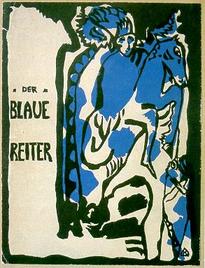
Der Blaue Reiter is a designation by Wassily Kandinsky and Franz Marc for their exhibition and publication activities, in which both artists acted as sole editors in the almanac of the same name, first published in mid-May 1912. The editorial team organized two exhibitions in Munich in 1911 and 1912 to demonstrate their art-theoretical ideas based on the works of art exhibited. Traveling exhibitions in German and other European cities followed. The Blue Rider disbanded at the start of World War I in 1914.

August Robert Ludwig Macke was a German Expressionist painter. He was one of the leading members of the German Expressionist group Der Blaue Reiter. He lived during a particularly active time for German art: he saw the development of the main German Expressionist movements as well as the arrival of the successive avant-garde movements which were forming in the rest of Europe. As an artist of his time, Macke knew how to integrate into his painting the elements of the avant-garde which most interested him. Like his friend Franz Marc and Otto Soltau, he was one of the young German artists who died in the First World War.

Alfred Leopold Isidor Kubin was an Austrian printmaker, illustrator, and occasional writer. Kubin is considered an important representative of Symbolism and Expressionism.

The Neue Galerie New York is a museum of early twentieth-century German and Austrian art and design located in the William Starr Miller House at 86th Street and Fifth Avenue in New York City. Established in 2001, it is one of the most recent additions to New York City's famed Museum Mile, which runs from 83rd to 105th streets on Fifth Avenue in the Upper East Side of Manhattan.
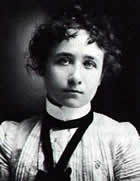
Gabriele Münter was a German expressionist painter who was at the forefront of the Munich avant-garde in the early 20th century. She studied and lived with the painter Wassily Kandinsky and was a founding member of the expressionist group Der Blaue Reiter.

The Lenbachhaus is a building housing an art museum in Munich's Kunstareal.

The Neue Künstlervereinigung München (N.K.V.M.), was an Expressionism art group based in Munich. The registered association was formed in 1909 and prefigured Der Blaue Reiter, the first modernist secession which is regarded as a forerunner and pathfinder for Modern art in 20th-century Germany.
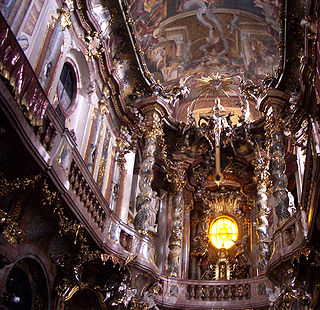
The Asam brothers were sculptors, painters, and architects, who worked mostly together and in southern Germany. They are among the most important representatives of the German late Baroque.
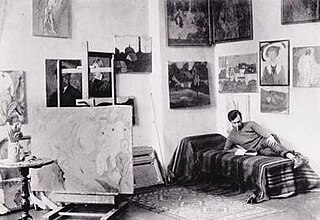
Albert Bloch was an American Modernist artist and the only American artist associated with Der Blaue Reiter, a group of early 20th-century European modernists.
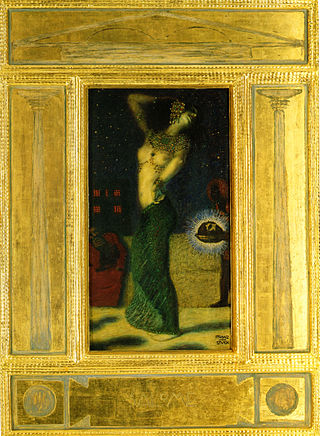
Salome is the title of two oil on wood paintings by the German artist Franz Stuck, both created in 1906. They depict Salome, daughter of Herod II and Herodias, an historical and biblical figure, dancing with joy as the head of John the Baptist is brought to her by a servant. Stuck was inspired, among other things, by the contemporary play by Oscar Wilde, the focus of which is Salome as a femme fatale.

Elisabeth Erdmann-Macke was a German writer who focused on memoirs of her time as the wife of the expressionist painter August Macke, who had portrayed her more than 200 times. He died in World War I. Later, she lived in Berlin with her second husband, Lothar Erdmann, who died in a concentration camp during World War II. She saved Macke's paintings and copies of his letters by moving them from her house in Berlin before it was bombed in 1943.

Bernhard Koehler was a German industrialist and art collector.
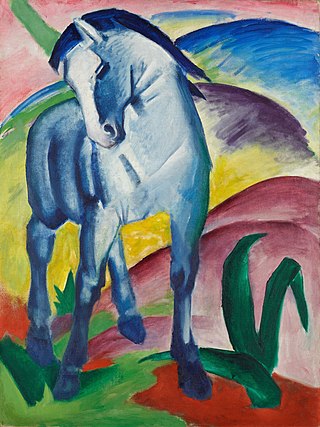
Blue Horse I is an oil painting by Franz Marc executed in 1911. It is one of the painter's most famous paintings and is part of the collection of the Städtische Galerie im Lenbachhaus in Munich. The painting was part of several exhibitions that fellow Russian painter Wassily Kandinsky and Franz Marc presented to the public under the name Der Blaue Reiter from late 1911 until 1914.

Indians on Horseback is an oil-on-canvas painting executed in 1911 by the German Expressionist painter August Macke. It was created when the artist was under the influence of Cubism and had joined Der Blaue Reiter group through his friend Franz Marc. The painting belongs to the collection of the Städtische Galerie im Lenbachhaus, in Munich. It was donated by the Bernhard and Elly Koehler Foundation in 1965.
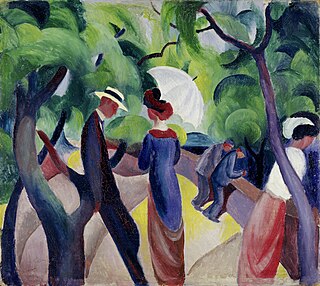
Promenade is an oil-on-cardboard painting by the German artist August Macke, executed in 1913. It is held at the Städtische Galerie im Lenbachhaus in Munich. Chronologically, it is the first of the paintings that he created after moving to Hilterfingen in Switzerland.

Girls in Green, also known as Girls under Trees, is an oil-on-canvas painting by the German painter August Macke, executed in 1914. It depicts a number of girls among the trees on the edge of a lake, where the color areas of the figures and the environment seem to merge. The painting is in the collection of the Pinakothek der Moderne in Munich.

Erster Deutscher Herbstsalon was the title of an art exhibition that was organized in 1913 by Herwarth Walden in Berlin.

Adolf Erbslöh was a German Expressionist painter; one of the founders of the Neue Künstlervereinigung München.

Swamp Legend ("Sumpflegende") is an oil-on-cardboard painting by Swiss German painter Paul Klee, from 1919. It has been in the Städtische Galerie im Lenbachhaus, in Munich, since 1982, but its ownership was disputed due to its provenance. The painting was one of the works considered by the National Socialists as “degenerate art” and was confiscated from the Landesmuseum Hannover, in Hanover, in 1937. However, it was not owned by the museum, but was there on a loan from the art historian Sophie Lissitzky-Küppers. In July 2017 it became known that her heirs had reached an agreement with the city of Munich abouts its ownership.



















